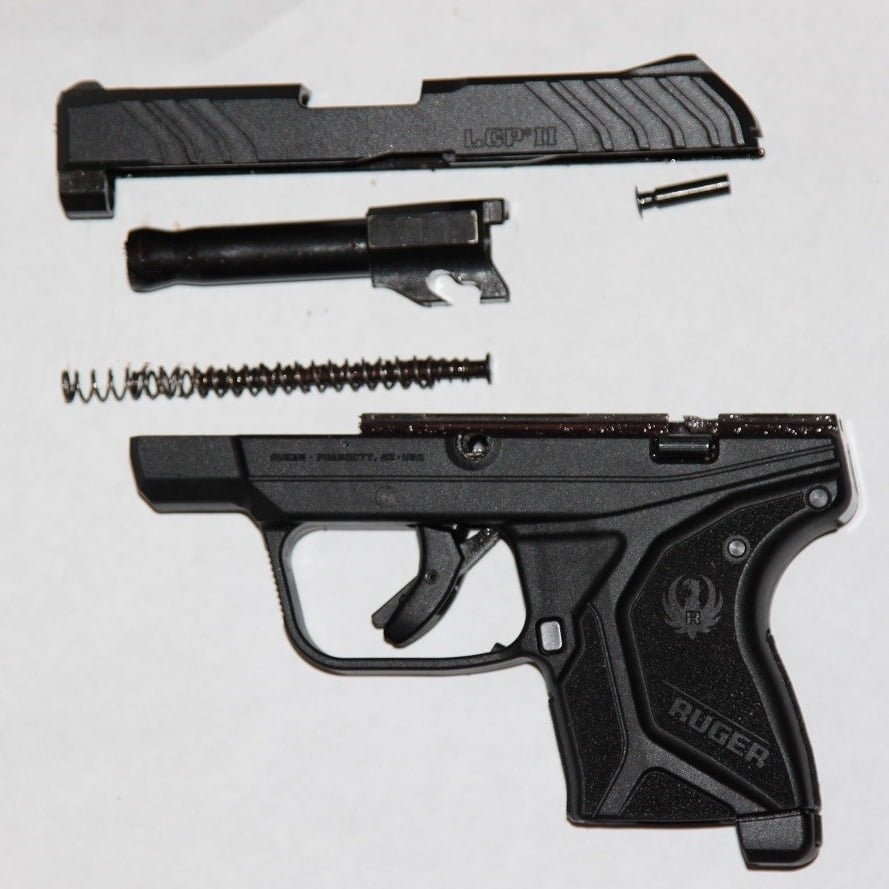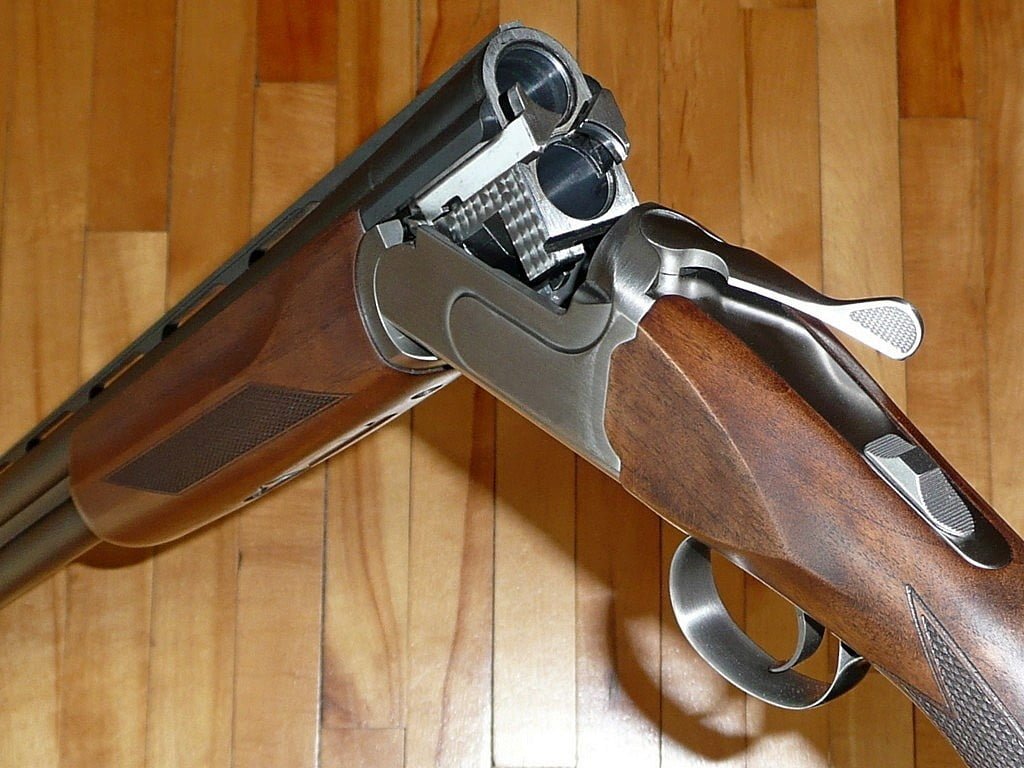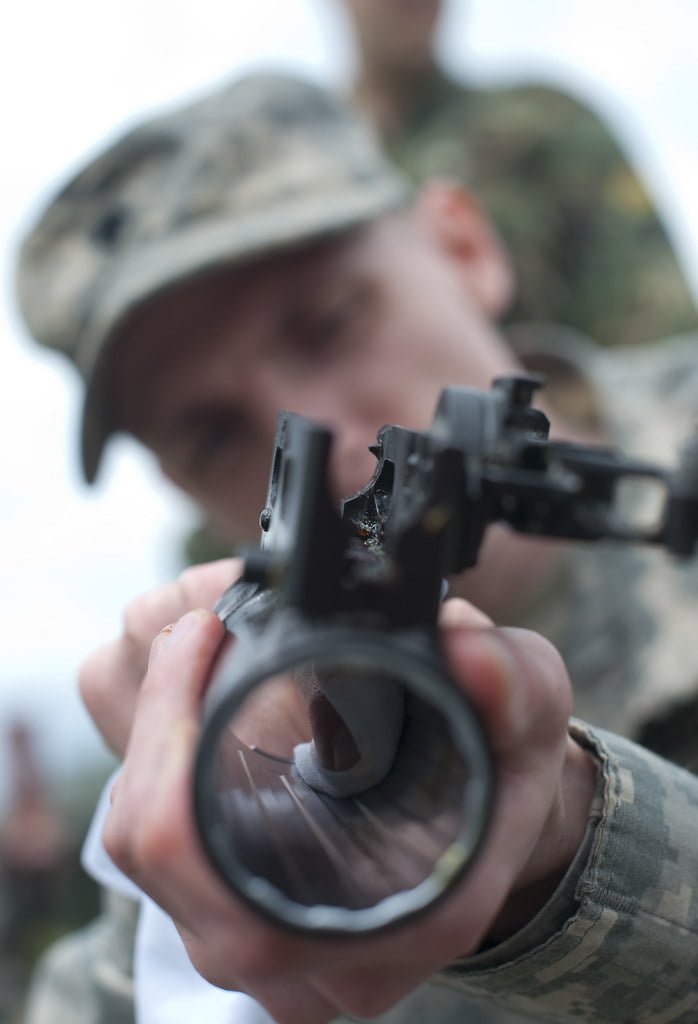Any firearm, just like a machine has moving parts that require cleaning and care to remain operational and to prolong the lifespan of that firearm.
Disassembling and maintaining your firearms can seem like a daunting task, but for most it turns out it’s quite the opposite. Knowing that your firearms are in their best working condition can be a huge relief, especially when used for personal defense. A jammed gun won’t defend you very well.

To properly care for your firearm, you need the right tools for the job. We’ll cover those tools and help you gain the knowledge to know where to start.
Gun Cleaning Kit
Let’s go over the tools and supplies you’ll need to care for your rifles, pistols and shotguns.
Solvent
The first of these is a good carbon-eliminating solvent. This will break down the carbon fouling or buildup that you get from firing your weapon. Some solvent and a cloth or cotton patches will help you get rid of the majority of the fouling.
Brushes
You’ll also need some brushes for scrubbing things to get an even deeper clean. It’s highly recommended to get yourself a brush set that has several brushes specific to the size of your barrel. This will help ensure your barrel maintains accuracy.
Punches
It also wouldn’t hurt to pick up a punch set. Some guns have pins to remove in order to give them a full cleaning and it can be difficult to remove those pins, especially when they’re dirty. A good punch set helps you to remove those pins without scratching up your firearm. The best part is these are very inexpensive and easy to use.
Lubricant
Lastly, you’ll want to pick up a good lubricant. This protects all of the moving parts in your firearm from damage or corrosion. There is a lot of debate on whether this should be oil or grease. While we don’t believe one is better than the other, there are a few things worth noting. Grease is thicker, making it last longer and resist higher temperatures. The downside to this is greater risk of gumming up with dirt and debris that is caught in the grease. If you’re in an area with a lot of dust, we recommend using a thinner oil to prevent this.
For anyone new to gun cleaning, your best choice is to get a pre-assembled gun cleaning kit. Cleaning kits provide everything you need to care for your gun from start to finish. The only thing you’ll have to worry about it restocking your supplies as they run out.
Cleaning a Pistol
The first and most important thing when cleaning any firearm is to make sure the gun is unloaded before you start. This is especially important when disassembling handguns as many pistols require that you pull the trigger to de-cock the gun.

You’ll want to remove the slide and barrel by following the instructions given by your firearm’s manufacturer. After removing these parts, you can begin cleaning. There are three important areas to clean:
Barrel
In order to properly clean the barrel, you’ll need solvent, brushes and cotton patches. Initially you’ll want to use your brass brush with some solvent to knock the fouling loose. After a few passes with your brush, you can switch to the cotton patches to clean out the rest of the carbon buildup and solvent. Once you’re finished with that, wipe off the exterior of the barrel with a cotton patch and a little solvent.
Frame
You can clean a pistol’s frame by using a toothbrush (or similar type of brush) and some gun solvent to clean up the carbon fouling. When finished cleaning up the frame with your brush, wipe the whole thing down with a cotton rag or patch until it’s dried out.
Slide
Cleaning your slide is very similar to how you clean the frame. Give it a good scrub with a toothbrush and some solvent to remove any carbon deposits, ensuring there isn’t any fouling that’s clogged up your striker channel.
Once you’ve finished cleaning all these areas, you’ll want to apply lubricant to the gun. Start with the rails that mate the slide with the frame. The barrel hood will also need lubricated as it’s another moving part. This is the same reason you should give your trigger assembly a light bit of lubrication. Lastly, make sure you add a small amount of lubrication to the inside of your barrel to prevent any damage or corrosion.
After all moving parts are lubricated, you can now reassemble the firearm, wipe off any excess solvent or lube and run the slide a few times to make sure it operates smoothly.
Cleaning a Shotgun
Many shotgun owners are lax on their care for these firearms because of their reputation for being extremely reliable. While carbon buildup likely won’t break your shotgun, it’s still important to care for the bore to prevent any corrosion.

Tools Needed
One of the most important tools you can have for cleaning a shotgun is a bore snake. These are a quick and easy way of cleaning the bore of your shotgun or rifle. The best part is, you don’t even have to disassemble your firearm for this.
Cleaning
Spray a little solvent on the bore snake or into the bore and feed the bore snake down the barrel. Each time you run the bore snake from chamber to muzzle, it will clean out the bore and swab it at the same time. After this is finished, adding a bit of lubricant to the barrel will ensure it’s protected from corrosion.
The next step is to clean out the choke using a brush and some solvent. You can get special choke solvents for this as well.
Lastly, a quick wipe down with some solvent on the breech bolt and chamber followed by some lubrication of each will finish up your maintenance. However, you may also want to clean out the magazine tube as carbon can occasionally get in and slow the follower.
Cleaning a Rifle
This can be a bit more complex depending on the rifle, but most modern rifles are built to allow them to be cleaned in the field without any issues.

Like cleaning your handguns, there are three primary areas to focus on with your rifles:
Barrel
Proper cleaning and maintenance of your rifle’s barrel can make a big difference in the firearm’s accuracy. Using a bore snake or brass brushes appropriate to your rifle’s caliber, you can apply some solvent and make a few passes from chamber to muzzle. This will clean out most of the fouling.
Bolt
Make sure the chamber is clear and remove any magazines. Then you can remove the bolt for cleaning. The bolt requires a bit more time and care than any other part on your rifle. At the very least, you’ll want to brush the entire bolt with solvent, but we recommend that you disassemble the bolt or bolt carrier group (BCG) to allow proper cleaning of all the components. This can be more complex and if you’ve never done this before, we’d recommend doing some research before attempting to do this.
Chamber & Receiver
The inside of your rifle will get covered with carbon buildup. Nothing a little solvent and a toothbrush can’t fix. Brush the internal surfaces while making sure to get your trigger group and chamber. Once finished, use a cotton patch to clean up the remaining solvent and carbon.
Once you’re finished cleaning, you’ll want to lubricate your rifle. This is very important in all rifles, but especially for AR style rifles. Make sure you lubricate every part of your rifle’s BCG, the takedown pins, buffer spring, forward assist, hammer, trigger assembly and charging handle. Lastly, apply a small amount of lubricant to the interior of the barrel to ensure no corrosion buildup. After you’re all finished up with lubricating your rifle, run the bolt a few times to make sure it operates properly and smoothly. Lastly, wipe off any excess oils or solvent that may have gotten onto the exterior.
Conclusion
Proper care and maintenance of your firearms ensures safety, longevity and accuracy are top notch. One last bit of advice when cleaning your firearms is to always wear gloves or wash your hands when finished. It may not seem important, but solvents can be harmful if you get them in your eyes and lead poisoning can happen from the lead particles you deal with when cleaning your firearm.
